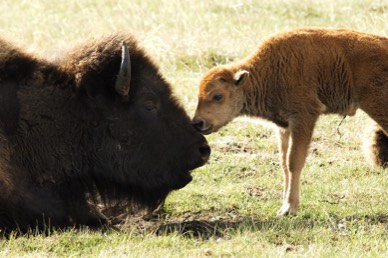The American bison (Bison bison), also commonly known as the American buffalo, is a North American species of bison that once roamed the grasslands of North America in massive herds, became nearly extinct by a combination of commercial hunting and slaughter in the 19th century and introduction of bovine diseases from domestic cattle, and has made a recent resurgence largely restricted to a few national parks and reserves. Their historical range roughly comprised a triangle between theGreat Bear Lake in Canada's far northwest, south to the Mexican states of Durangoand Nuevo León, and east to the Atlantic Seaboard of the United States (nearly to theAtlantic tidewater in some areas) from New York to Georgia and per some sources down to Florida, also in North Carolina where bison were seen near Buffalo Ford on the Catawba River as late as 1750.[2][3][4]
Two subspecies or ecotypes have been described: the plains bison (Bison bison bison), smaller in size and with a more rounded hump, and the wood bison (Bison bison athabascae)—the larger of the two and having a taller, square hump.[5][6][7][8][9][10] Furthermore, it has been suggested that the plains bison consists of a northern (Bison bison montanae) and a southern subspecies, bringing the total to three.[8] However, this is generally not supported. The wood bison is one of the largest wild species of bovid in the world, surpassed by only the Asian gaur and wild water buffalo. It is the largest extant land animal in the Americas.
